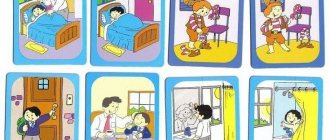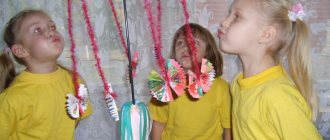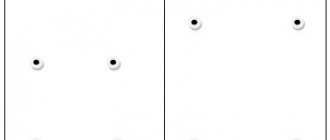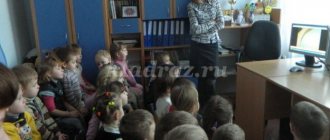MAGAZINE Preschooler.RF
Summary of direct educational activities on construction in the 2nd junior group “Gate Construction”Municipal budgetary preschool educational institution Child Development Center kindergarten "Korablik"
Prepared by: teacher of the first qualification category Vostryakova E.N. Udomlya
Target:
Develop in children the ability to build a simple floor: place supports (exactly one opposite the other) and carefully place crossbars on them. To develop in children the ability to analyze a sample building.
Tasks:
- Cultivate a desire to build buildings.
- Arouse children's interest in activities with wooden building materials.
- Develop the ability to listen carefully to the teacher and answer questions posed.
- Improve constructive skills.
Materials:
Illustration of kindergarten gates, cars of different sizes, gate diagrams
Dispenser: three small bricks, one long brick, two high bars. The demo is the same.
STROKE:
Stage 1: motivational.
- The goal of the teacher at this stage of the educational activity is to motivate children to play activities; develop emotional responsiveness and cognitive activity.
The goal that children should set for themselves is to build gates for cars.
An animation of the song “Beep-Bee-Bee” and cars come to visit the children. Develop emotional responsiveness.
Children enter the group room, greet guests and sit on chairs next to the teacher.
— Guys, look, a lot of cars came to our group today. They are not empty, but loaded with construction parts.
- Encourage children to think independently, encourage children with positive comments: “Clever” for girls, “Well done” for boys.
Stage 2 based on the personal experience of children (survey of children):
Pedagogical goal: To activate children’s personal experience, their ability to recognize and name construction parts.
The goal that children must achieve: Remember and name construction parts.
Educator:
- Let's see what construction parts are in our cars.
- What is this? (brick)
-What can you build from bricks? (house, path)
— And when you went to kindergarten in the morning, you saw the gate. They are beautiful and wide. (showing the gate)
- What do you think the gates are for? (come in, go out)
— Do you want to learn how to build gates? (Yes)
Stage 3 is the main one.
Pedagogical goal: To develop in children the ability to build a simple floor: place supports (exactly one opposite the other) and carefully place crossbars on them. To develop in children the ability to analyze a sample building.
The goal that the children set: Build a gate.
The teacher gives simple explanations. All the details are different, they differ from each other either in shape, or in color or in size.
- Introduction and examination (examination and identification of sensory signs of building parts)
— Look how I will build a gate (show)
I will build the supports from bricks, placing them opposite each other like this. I will also build the crossbar from small bricks. I place it on the supports with the wide side.
- Demonstration of the phased construction of gates.
— Do we have a gate?
— What kind of cars do you think can get through such a gate, small or large cars?
- Guys. Small cars can pass through these gates.
- Look. How I drew this gate. (shown on the diagram)
“Now you can build the gate yourself.”
- Let's imagine. That we got into our cars and went to a construction site to build gates. But before our cars go, we need to pump up the tires (Imitation) and start the engines (Imitation).
- At this stage, NOD relieves muscle tension.
Note: Children work at tables.
- Well done, what a beautiful gate you have made. Now take the car and drive it through your gate. Happened? (Children's answers).
- At this stage, children's activities are independent in creating and playing with buildings.
Stage 4: consolidating the experience gained on new material.
Pedagogical goal: To consolidate the experience gained by children using new material.
Goal for children to set: Build a big gate.
— Guys, I also brought you big cars. Tell me, can this car drive through your gate? (Children try).
- Create a problem situation, Encourage children to think independently.
The teacher opens the screen, showing the large gate.
-Look how I built it. This gate has a support, a crossbar, and we will build it from other building parts. The supports are made of bars, the crossbar is made of long bricks.
— I suggest you build the same gates for large cars. Come, take big cars and build big gates for them.
- At this stage, children's activities are independent activities.
— Did your cars pass through the gate? Did you get the same gate as mine?
- At this stage, GCD compares your construction with the model.
Stage 5 – final:
Pedagogical goal: Aim at generalizing the experience gained and applying it in the game.
The goal that the children set is to play with cars now, and tomorrow to build gates for other cars.
— Guys, tell me, what did you build today? (Children's answers). Did you enjoy building? (Yes).
- Well done, what a beautiful and durable gate you have made. We will still play with you tomorrow, we will definitely build more gates for other cars. Now let's invite the cars to stay in our group and you can play with them. (Children agree).
Animation starts and children play with the buildings.
| Next > |
Organization of construction games in the second junior group
Thus, the basis of construction-constructive play is an activity in which children reflect the life around them in a variety of buildings using various materials and playful actions with them.
Educational and developmental influence
of construction-constructive games on a child
Construction-constructive games contribute to the child’s development of:
- creativity,
- constructive thinking,
- spatial imagination,
- fantasies,
- create different models,
- knowledge of color, size, shape.
The concept and content of construction games contain one or another mental task, the solution of which requires preliminary thinking: what to do, what material is needed, in what sequence the construction should take place.
In the process of construction-constructive games, an adult teaches children to observe, distinguish, compare, remember and reproduce construction techniques, and focus on the sequence of actions. Children learn how to make a building, learn to plan the work, presenting it as a whole, and carry out analysis and synthesis of the building.
Construction games promote positive relationships between peers. Construction and construction games are of a group or collective nature and therefore contribute to the development of mutual understanding, teach them to be attentive to other children, and communicate with peers and adults. In addition, children noticeably develop an interest in technology and the ability to finish a job; see the result of collective work, its benefits.
Construction-constructive games are an opportunity to master a precise vocabulary (speech is enriched), expressing the names of geometric bodies, spatial relationships: high - low, right - left, up - down, long - short, etc.
In construction games, a child’s varied motor activity is demonstrated and coordination of movements develops. Of particular importance is the development of small muscles of the hand and the eye. By constructing buildings from large parts, children make the physical efforts available to them, show endurance and endurance.
Thus,
construction games significantly influence the development of a preschool child.
Conditions for playing with building materials
For construction games, special conditions must be created: the availability of the necessary building material. The following types of building materials are distinguished:
- natural (sand, snow);
- utility room (boards, boxes, boxes, etc.);
- specially created (floor, tabletop building material, Lego-type sets; mosaic:
- geometric,
- circular,
- small
It is necessary to provide a time during the day and a place for these games. The material should be varied, attractively designed, sustainable, and appropriate for the age of the children.
- It is better to store small building materials and construction sets in a closet or on a rack accessible to children.
- Large building materials are located away from the tables, since construction games require more space, as children often unite in groups of several people, talk, consult, move parts, and make changes to buildings.
Typically, a permanent place is allocated for storing building materials - a construction corner. The parts are folded neatly, steadily, in order to comply with safety regulations. Young children take the material and put it away after playing with the help of an adult, and older preschoolers do it all on their own.
Children must be introduced to the procedure for storing building materials, require careful handling and respect for buildings.
To play around with buildings, it is necessary to create conditions by selecting small toys (cars, figurines of animals, people, etc.). An important condition for construction games is their theme
.
For example: in the second younger group (3-4 years)
– gates, paths, truck, furniture for dolls, houses, turrets, garage, train, fences for animals, birds, etc.;
in the middle group (4-5 years old)
- two-story houses, a steamboat, a slide with a ramp, a garage for two cars, a bridge, a railroad and a train, etc.;
in the older group (5-6 years old)
- an airplane, various cars, a street, a kindergarten, a zoo, various steamships, pedestrian and automobile bridges, etc.;
in the preparatory group (6-7 years old)
- fairy-tale houses, river and railway stations, theatre, multi-storey buildings, various airplanes, metro, a tower based on a fairy tale, etc.
Guidance of construction and construction games with building materials
Children really love construction and construction games . Moreover, these games captivate both boys and girls equally. In domestic preschool pedagogy, a number of studies have been devoted to the methodology of developing constructive skills in children (E. A. Flerina, Z. V. Lishtvan, A. N. Davidchuk, L. A. Paramonova). The main idea of this technique is to lead the child from imitating the actions of an adult to independently solving constructive problems of increasing difficulty.
Children acquire basic skills:
- during the learning process in design classes;
- in joint activities with an adult;
- and then transfer them, transforming, supplementing and varying them into independent construction games.
To develop children's interest in these games, the teacher uses various techniques:





